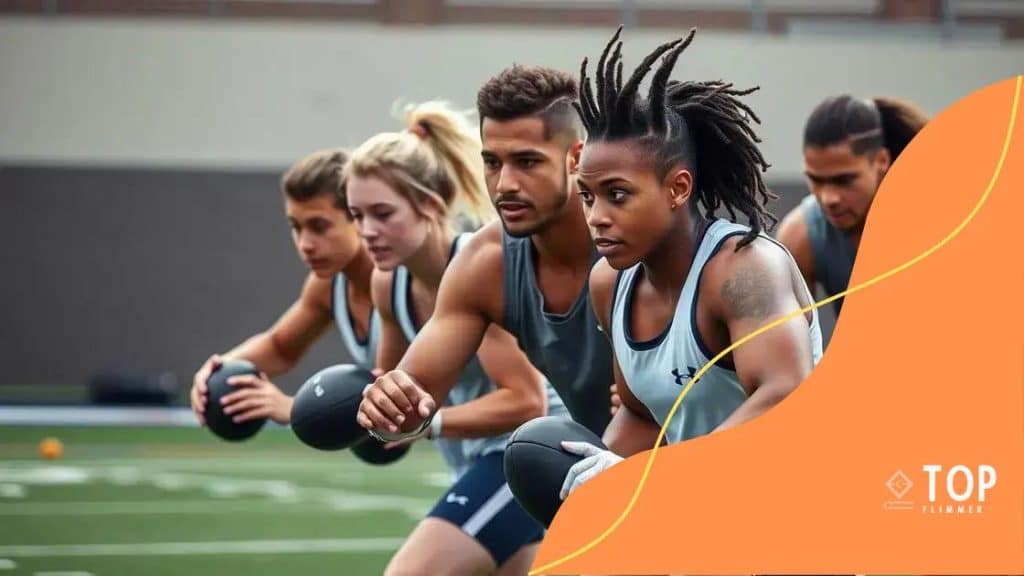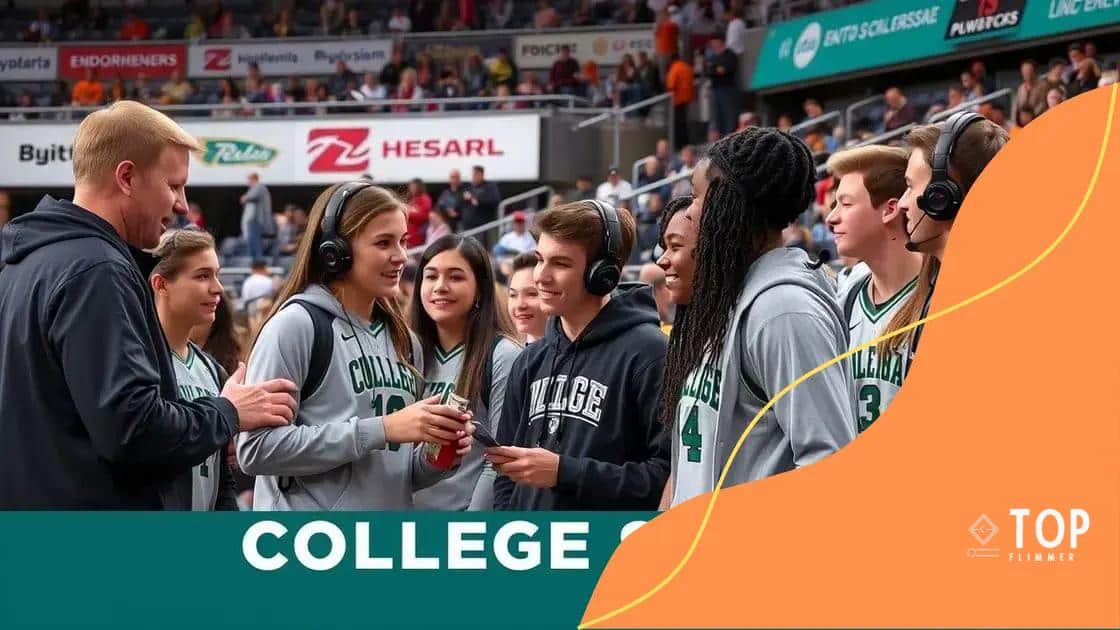New policies for student-athlete rights: what to know

New policies for student-athlete rights empower athletes by allowing them to profit from their name, image, and likeness while ensuring better support systems and equitable opportunities in college sports.
New policies for student-athlete rights are reshaping the landscape of college athletics. These changes aim to empower athletes while ensuring fair treatment within the system. Curious about how these updates could influence the future of sports? Let’s dive in!
Understanding student-athlete rights
Understanding student-athlete rights is essential for both athletes and educational institutions. It’s important to recognize how these rights have evolved.
What Are Student-Athlete Rights?
Student-athlete rights refer to the protections and privileges granted to athletes within educational settings. These rights ensure that athletes have voice and agency over their own lives and careers.
Key Aspects of Student-Athlete Rights
These rights include various elements that protect athletes:
- Scholarships: Many student-athletes receive scholarships that cover tuition and living expenses.
- Health and safety: Institutions must prioritize the health and safety of their athletes.
- Fair treatment: Athletes should not face discrimination or unfair treatment based on their athletic status.
- Representation: Athletes have the right to be part of decisions that affect their well-being.
The rise of student-athlete rights has been fueled by increased awareness of the challenges athletes face. For instance, many athletes struggle with balancing academics and sports commitments. As a result, educational institutions are more frequently evaluating how they can support student-athletes better.
Impact of New Policies
The new policies significantly impact how rights are enforced and recognized. Some athletes are now able to profit from their name, image, and likeness, which was previously restricted. This change opens up new opportunities for athletes while emphasizing the importance of education alongside athletics.
In addition to policy changes, advocacy groups have emerged to support athletes in understanding their rights. These groups provide resources and information, assisting student-athletes in navigating their academic and athletic journeys.
As student-athlete rights continue to gain momentum, it’s vital for athletes to stay informed. Knowledge about one’s rights can empower individuals, making a substantial difference in their experiences in sports and education.
Key changes in recent policies
Key changes in recent policies have significantly impacted student-athlete rights. These changes aim to provide better support and more opportunities for athletes.
New Regulations Overview
Recent policy updates have emphasized fairness and equity for all student-athletes. This shift reflects a growing acknowledgment of the challenges athletes face while balancing sports and academics.
Opportunities for Athletes
One notable change is the increased ability for athletes to profit from their name, image, and likeness. This adjustment allows athletes to earn money through endorsements, social media, and personal appearances.
- Sponsored posts: Athletes can now create content for brands on their social media platforms.
- Merchandise sales: Many athletes are launching their own merchandise lines.
- Partnerships: Some colleges are establishing partnerships with local businesses to help athletes promote their brands.
These opportunities highlight a more supportive environment for student-athletes. Additionally, the policies focus on protecting the rights of athletes during recruitment and competitions.
Another significant advancement includes improved health and safety regulations. Institutions must now prioritize the mental and physical well-being of athletes, ensuring they have access to appropriate medical care.
Implications for Future Policies
The recent changes set a precedent for future policies focusing on student-athlete rights. As institutions adopt these new guidelines, the dialogue around athlete treatment and compensation will likely continue to evolve.
These shifts suggest a promising future where student-athletes are empowered and supported throughout their collegiate careers. Understanding these key changes is essential for athletes, coaches, and educational institutions alike.
Impact on college sports

The impact on college sports due to recent policy changes for student-athlete rights is profound. These changes are redefining how athletes engage with their colleges and the sports they love.
Increased Opportunities for Athletes
With the new regulations, athletes now have more chances to monetize their abilities. This means they can participate in endorsement deals, promoting brands that resonate with their personal image.
- Enhanced visibility: Athletes can showcase their skills on social media, increasing their professional opportunities.
- Personal branding: Athletes are creating personal brands, allowing them to connect directly with their audience.
- Financial benefits: More athletes are earning significant income through these new channels, helping them during and after their college careers.
This shift not only empowers athletes financially but also encourages them to take charge of their personal stories.
Shifting Dynamics in College Athletics
The dynamics of college athletics are shifting as institutions adapt to these changes. Coaches and athletic programs must now consider how they can support their athletes better.
For example, schools are investing more in educational resources to help athletes manage their new responsibilities regarding sponsorships and partnerships. This focus is critical as it helps athletes balance their academics with their athletic commitments.
Additionally, there’s a greater emphasis on mental health support. Institutions are recognizing that the pressures of balancing sports with academics can be overwhelming for student-athletes. By providing mental health resources, colleges are promoting a healthier, more supportive environment for their athletes.
The Future of College Sports
As these policies continue to evolve, the future of college sports looks promising. The landscape will increasingly focus on creating equitable opportunities for all athletes, ensuring they are treated fairly and provided with the necessary support. As a result, both collegiate athletes and the sports they represent are likely to flourish in this new environment.
Scholarships and financial implications
Scholarships and financial implications are crucial aspects of student-athlete rights. Many athletes rely on scholarships to fund their education while pursuing their sports careers.
Types of Scholarships
Scholarships can vary greatly, depending on the sport and the institution. The most common types include:
- Full scholarships: These cover tuition, fees, room, and board, offering a comprehensive financial solution for athletes.
- Partial scholarships: These provide a portion of the funding, helping athletes manage some of their costs.
- Merit-based scholarships: Some scholarships are awarded based on athletic performance and academic achievements, encouraging a balanced approach.
Understanding these options is essential for athletes as they navigate their educational journeys.
Financial Implications of Scholarship Programs
Scholarships have significant financial implications for student-athletes. They not only reduce the financial burden of college education but also can lead to increased opportunities in professional sports.
For instance, with the right scholarship, athletes can focus more on their training and education without the stress of financial instability. This situation allows them to perform better in their sports, potentially leading to professional contracts in the future.
Additionally, changes in policies around student-athlete rights may impact how scholarships are structured. As athletes gain more freedom to profit from their skills and likeness, schools might adjust their scholarship offers to remain competitive.
Moreover, managing finances is another skill students should develop while in college. Many programs now include financial literacy courses to help athletes make informed decisions about their scholarships and future earnings.
The Future of Scholarships
The landscape of scholarships is evolving, especially with new regulations in place. Schools are finding innovative ways to support student-athletes financially while promoting equity and fairness in sports. Understanding these changes helps athletes maximize their potential both on and off the field.
Future outlook for athletes
The future outlook for athletes is bright, especially with recent changes in student-athlete rights. These developments are shaping a new era in college sports.
Empowerment through Policy Changes
Recent policy changes have empowered athletes to take control of their journeys. With a greater ability to profit from their name, image, and likeness, athletes now have more opportunities than ever before.
This shift allows athletes to focus not just on sports but also on building their personal brands. For many, these skills can translate into successful careers after sports, whether in business, entertainment, or community leadership.
Supportive Environments in Colleges
Colleges are recognizing the importance of creating supportive environments for athletes. This includes not only academic support but also mental health resources and career planning services.
With these resources, athletes can better manage the demands of their sports and education. Programs are increasingly offering workshops on financial literacy, ensuring that athletes can navigate their earnings wisely.
The Road Ahead
As more states and institutions adopt supportive policies, the landscape of college athletics will continue to evolve. This evolution will focus on fairness and inclusion, providing athletes with equitable opportunities.
The increased dialogue about student-athlete rights is helping to elevate the voices of athletes. As these athletes advocate for their needs, they are shaping a future where they can thrive both on and off the field.
Ultimately, the future looks promising for student-athletes who are prepared to seize new opportunities. They are not just athletes; they are students and future leaders ready to make an impact.
student-athlete rights are transforming the landscape of college sports. Athletes now have more opportunities, better support systems, and a voice in their futures. These developments promise a brighter path for student-athletes, empowering them to thrive both academically and athletically. As colleges adjust to these changes, the focus remains on fairness and equity, ensuring success for all involved.
FAQ – Frequently Asked Questions about Student-Athlete Rights
What are student-athlete rights?
Student-athlete rights refer to the protections and privileges that ensure athletes can participate in sports while receiving fair treatment in education and financial opportunities.
How do recent policy changes affect athletes?
Recent policy changes allow athletes to profit from their name, image, and likeness, giving them more financial opportunities and control over their personal brand.
What types of scholarships are available for student-athletes?
Scholarships can be full or partial, covering tuition and other expenses based on athletic ability, academic performance, or both.
How can colleges support student-athletes better?
Colleges can provide enhanced academic resources, mental health support, and financial literacy education to help student-athletes manage their responsibilities.






